#erect crested penguin
Text
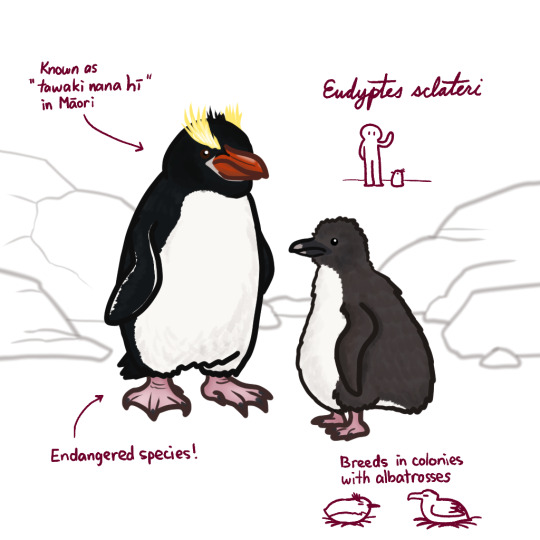
Little is known about the erect-crested penguin, because research is hampered by the remoteness of the two islands (Bounty and Antipodes Islands) they breed on and the difficulty of getting permits to visit said islands.
#march of the penguins#penguin#bird#erect crested penguin#tawaki nana hi#endangered species#education#art
16 notes
·
View notes
Text
All penguin species (1/2)

Adélie penguin (Pygoscelis adeliae)
(X) <-

African penguin (Spheniscus demersus)
(X) <-

Chinstrap penguin (Pygoscelis antarcticus)
(X) <-
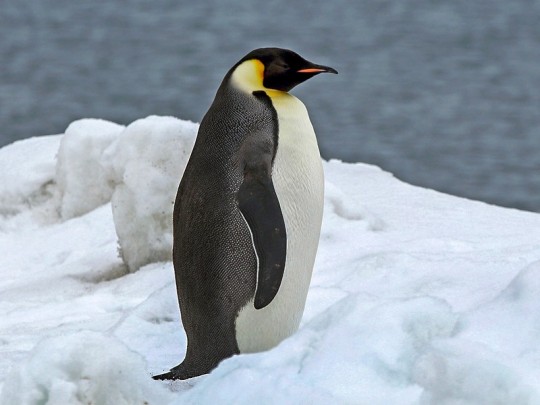
Emperor penguin (Aptenodytes forsteri)
(X) <-

Erect-crested Penguin (Eudyptes sclateri)
(X) <-

Fiordland Penguin (Eudyptes pachyrhynchus)
(X) <-
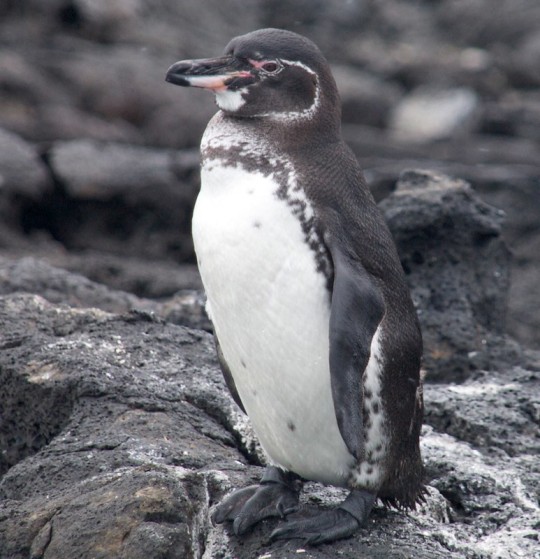
Galápagos penguin (Spheniscus mendiculus)
(X) <-

Gentoo penguin (Pygoscelis papua)
(X) <-
#Penguin#penguins#adelie penguin#african penguin#chinstrap penguin#emperor penguin#erect crested penguin#fiordland penguin#galapagos penguin#gentoo penguin#pygoscelis adeliae#spheniscus demersus#pygoscelis antarcticus#aptenodytes forsteri#eudyptes sclateri#eudyptes pachyrhynchus#spheniscus mendiculus#pygoscelis papua#arctic animals#Arctic Wildlife#animal#animals#nature#wildlife#wild animals#chordata#aves#sphenisciformes#spheniscidae#pygoscelis
52 notes
·
View notes
Text
Round 1 Match 1


The Erect-Crested penguin is one of many crested penguins. These guys live in the New Zealand region and are on the endangered species list. They only breed on the Bounty and Antipodes Islands near New Zealand. Erect-Crested penguins are around 20-28 inches (50-70 cm) tall.
The Little Blue penguin, also called the Fairy penguin, Blue penguin, or Little penguin, is the smallest penguin, standing at a height of about 12-14 inches (30-40cm). They also live in the New Zealand region. Little Blues earned their name with their bluish feathers. These penguins burrow for their nests, and lay two eggs, like most other penguins. The first part of their scientific name "Eudyptula minor" means "good little diver".
#polls#penguins#penguin competition#penguin tournament#round 1#tumblr poll#bracket#penguin#tournament#erect-crested penguin#little blue penguin#fairy penguin
40 notes
·
View notes
Note
could you do penguins? any species is ok
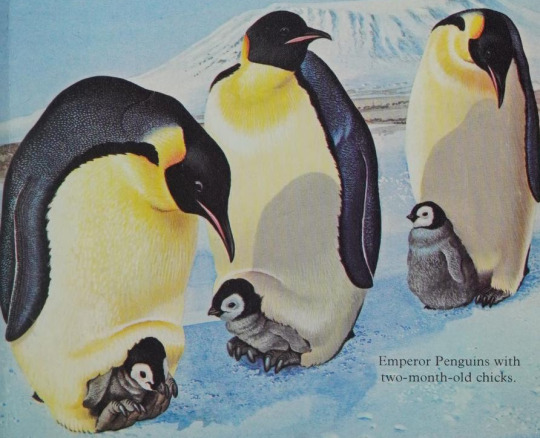

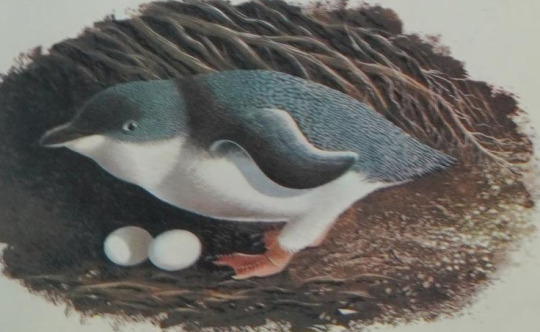


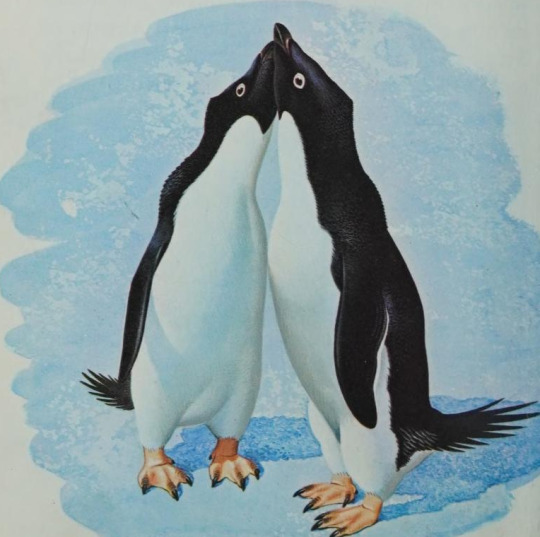
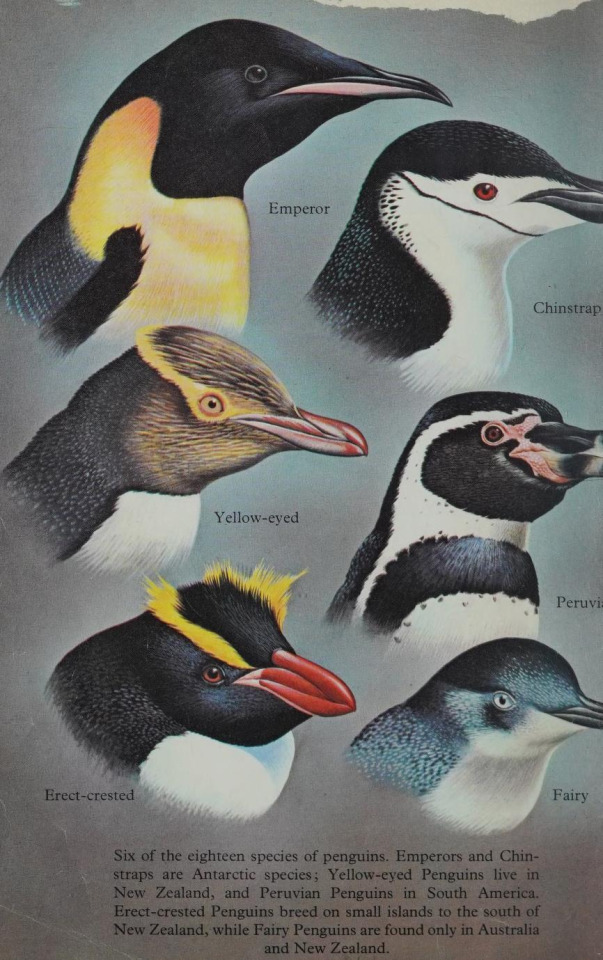
Penguins. Written by Bernard Stonehouse. Illustrated by Trevor Boyer. 1979.
#birds#penguins#emperor penguins#snares island penguins#adelie penguins#gentoo penguins#fairy penguins#chinstrap penguins#yellow-eyed penguins#erect-crested penguins#peruvian penguins#Trevor Boyer#replies#requests#anonymous
111 notes
·
View notes
Text
The crested penguins of New Zealand. In Maori they are called “Tawaki”. Belonging to the genus Eudyptes, they are the Fiordland penguin (E. Pachyrhynchus), the Snares (E. Robustus) and the Erect-crested (E. sclateri).
Due to how closely related they are, it is debated whether they are a single species with three subspecies, or three distinct species. It’s difficult to tell them apart since they are so similar.

above: the fiordland penguin
Unlike the other two species, the fiordland penguin has small white stripes underneath its eyes, and has no bare skin around its beak. Like the snares penguin, its crest (the yellow eyebrows) does not stand up. This penguin is known for swimming very far for food. These chaps nest in forests.

above: snares penguin
the snares penguin looks almost exactly like the fiordland penguin, but it lacks the white stripes below its eyes, and has a bare area of skin around the beak. The fellows breed on the Snares Islands.

this is the erect-crested penguin. Like the snares penguin, it has a bare area of skin around its beak. Unlike the other two species, it has a crest that stands up, hence the name. These guys only breed on the Bounty and Antipode islands.
5 notes
·
View notes
Text
disclaimer: this list is wikipedia-sourced. taxonomists disagree about the exact number of penguin species.
go to this website for a quick species rundown!
#penguins#polls#if you didn't have a favorite before now's the time!#my answer is banded/jackass btw. have always loved them. funky lil guys
240 notes
·
View notes
Note
For the fanfic director’s cut: ⭐️⭐️⭐️
I was going to respond seriously to this, but when I went to find the appropriate googledoc, the googledoc I had open already was "Penguins (A Divine Quest, Probably)", the planning doc for the D&D 5e campaign I ideated by never ran (yet). The premise is: all players are penguins in a post-apocalyptic world in which nuclear radiation a) returned magic to the world and b) made penguins sentient and gave them mild tactile telekinesis, ie, the ability to manipulate (moderately lightweight) objects with their mind while physically touching them (to avoid issues like 'no thumbs' and 'average penguin is about 3ft tall and minimal strength'.)
So I'll share my list of species correlations instead, including reasoning:
Great Penguins
Emperor - BIG BOYS (36-37kg), no nests - Goliath
King - lorge (15ish kg), chicks grow slowly, yellow feather “crown”, deep divers, common - Minotaur
Brush-Tailed Penguins
Adelie- medium (5ish kg), particularly cold-resistant, line nests with stones, common - Elf
Chinstrap - 5ish kg, pretty (says this site), nest on slopes, common - Half-elf
Gentoo - standardish penguins? 5+a bit kg, Antarctic continent + islands, like crab, common - Human
Little Penguins
Little - SMOLEST CHILDES (1ish kg), nocturnal, common - Svartniblin
Fairy - ditto smol and habitat?? - Gnome
Banded Penguins
Galapagos - smol! (2ish kg), equatorial (very good in heat) - Halfling
African - 3ish kg, burrow much, used to warmer (African) weather - Dwarrow-Dwarf
Humboldt - 5-a bit kg, burrow some, occupy cold Peruvian current but hot (desert/Mediterranean) breeding site. Fucked by El Nino some years - Mountain Dwarf
Magellanic - 5-a bit kg, burrow breeders, ~ African but South American - Hill Dwarf
Large Divers
Yellow-eyed - 5.5ish kg, maybe rarest penguin, nest in plants - Aasimar
[EXTINCT] Waitaha
Crested Penguins
Rockhopper (Southern, Eastern, Northern) - 2.5ish kg, red eyes, tiny but fierce - Goblin
Snares - 3ish kg, endemic to Snares Islands, kill forest with guano quantity, yellow eyebrows - Hobgoblin
Fiordland - 4ish kg, endemic to New Zealand rainforests - Half-orc
Macaroni - 5+a bit kg, don’t Land much when not breeding, weird orange hair - Kobold
Erect-crested - 5ish kg, tall crests (~horns!) - Tiefling
Royal - 5+a bit kg, related to Macaroni probably (yellow hair), nest in open. Standardish - Dragonborn
[EXTINCT] Chatham
Humans = giants, 1 enclave per type
Other birds (terns, mostly? not albatross? Must really live there) arakockra
Genasi may be done as a half-heritage thing, ie, half genasi, half established race
18 notes
·
View notes
Text
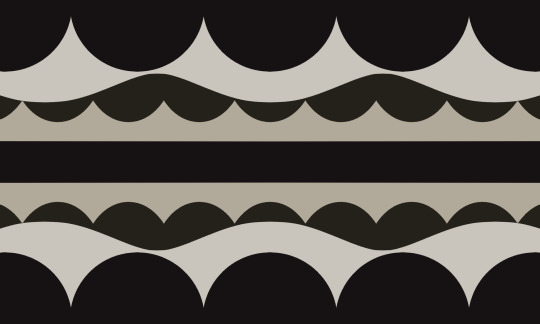




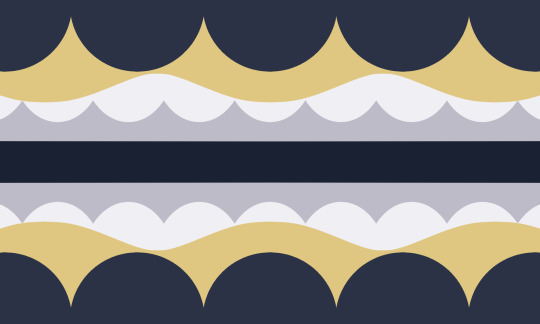




afripengyfrilled , aussielilpengyfrilled , royalpengyfrilled
erectrestpengyfrilled , fiordpengyfrilled
snarepengyfrilled , rockhopengyfrilled , humpengyfrilled
gentoopengyfrilled , lilbluenguinfrilled
a gender for when ones gender is related to a breed of penguin and frills, a penguin wearing frills, a frilly penguin, etc.
african penguin / australian little penguin / royal penguin
erect-crested penguin / fiordland penguin
snares penguin / rockhopper penguin / humboldt penguin
gentoo penguin / little blue penguin
TAGLIST ! (lmk if you want to be added/removed) : @gender-darling @genderserpentine @botbinary @hoardicboy @mogai-sunflowers @noxwithoutstars @the-almond-and-the-apple @boxesofnoxes @aetherive @karkitz @reveseke @revenant-chaos @t1dez @corbybug @heart-valentin3 @checkers-entertainments @loveless-lovesickness @waliwiwige @nepetaisms @begendered-mogai @diary-of-apathy @radiomogai @bpd-hoardic @faunfaced @pullerofstrings @kiruliom @gummysharko @imvasic @nyan-editmaidcafe
#afripengyfrilled#aussielilpengyfrilled#royalpengyfrilled#erectrestpengyfrilled#fiordpengyfrilled#snarepengyfrilled#rockhopengyfrilled#humpengyfrilled#gentoopengyfrilled#lilbluenguinfrilled#genderfrilled#xenogender#mogai#liom#neogender#— now broadcasting
17 notes
·
View notes
Text
Phylogeny Guessing Game: Seabirds
Which of the two following birds are more closely related, and which one is the outgroup? Answers under the cut. (Disclaimer: I'm not a bird scientist, just a gal reading Wikipedia, so if the latest science disagrees with any of these, please let me know! Also I am linking to the Wikipedia pages for all of these birds, so you see the relationships as they currently stand for yourself)
Round 1:
A) Quail plover (Ortyxelos meiffrenii) (Nigel Voaden)
B) European herring gull (Larus argentatus) (Andreas Trepte)
C) Short-tailed albatross (Phoebastria albatrus) (James Lloyd)
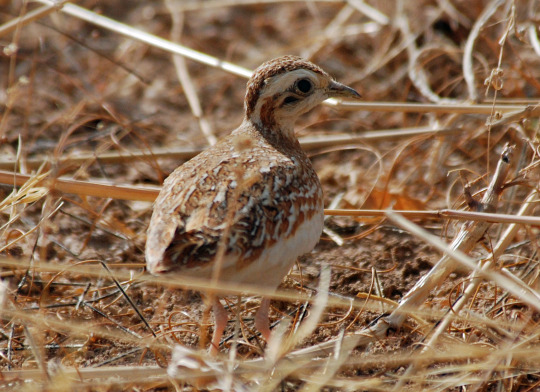

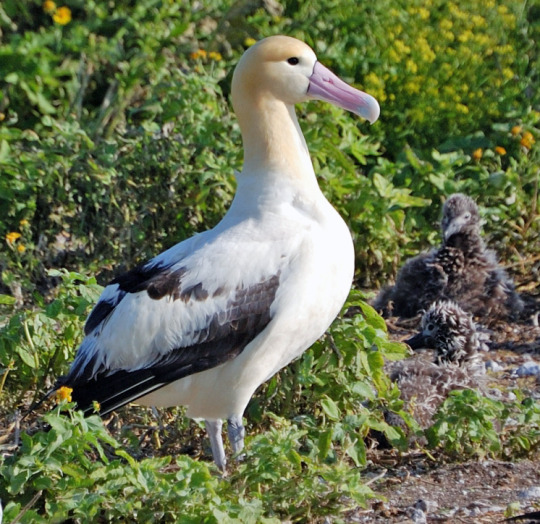
Round 2:
A) Parakeet auklet (Aethia psittacula) (Art Sowls)
B) European herring gull (Larus argentatus) (Andreas Trepte)
C) Great skua (Stercorarius skua) (Ómar Runólfsson)


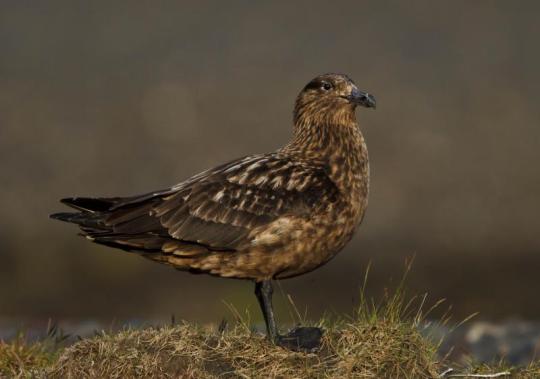
Round 3:
A) Parakeet auklet (Aethia psittacula) (Art Sowls)
B) Erect-crested penguin (Eudyptes sclateri) (C00ch)
C) Short-tailed albatross (Phoebastria albatrus) (James Lloyd)

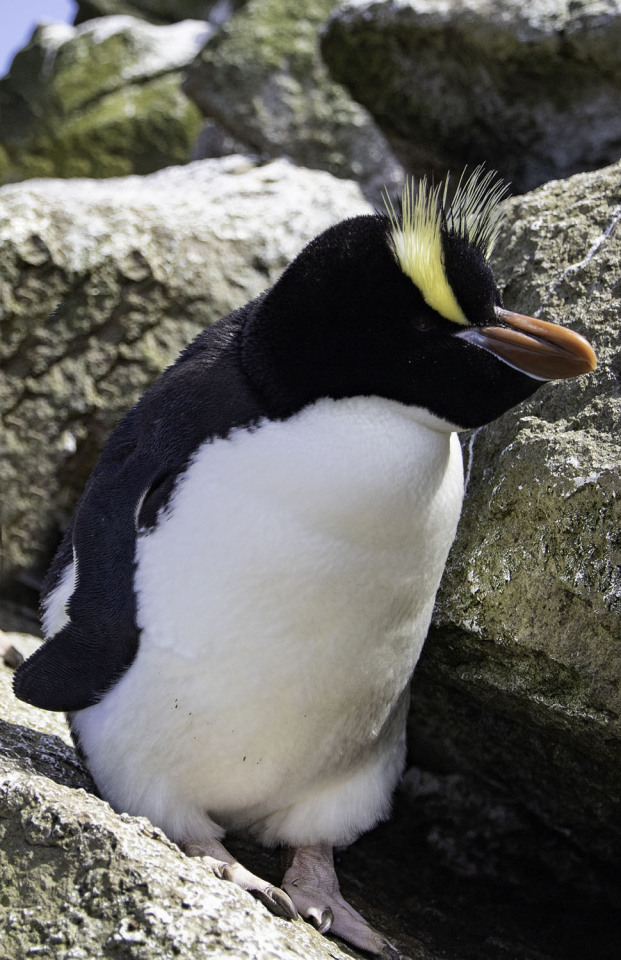

Round 1: A and B, not C
The quail plover (A) and the European herring gull (B) are both in the order Charadriiformes (and maybe both in the suborder Lari depending on who you ask?), while the short-tailed albatross (C) is in the order Procellariiformes.
Round 2: A and C, not B
These are all in the suborder Lari, but the auks (Alcidae) like the parakeet auklet (A) and the skuas (Stercorariidae) like the great skua (C) are closer to each other than they are to gulls like the European herring gull (B) (in Laridae with terns, skimmers, and some other seabirds).
Round 3: B and C, not A
The erect-crested penguin (B) and the short-tailed albatross (C) are both members of Austrodyptornithes, which is the penguins (Sphenisciformes) plus the tube-nosed seabirds (Procellariiformes) like albatrosses, while the parakeet auklet (A) as previously discussed is Charadriiform
thanks for playing my bird game!
#bio#aves#dinosauria#taxonomizing#wiki#there are a lot of funny penguins but i tried to find the funniest one#everyone else gets classy casual standing poses#well the auklets do look like they're about to tumble off that cliff but i think they're fine
8 notes
·
View notes
Text
y'know what after the "vesper, you're a penguin" thang i keep wondering this so.
because of the 10 option limit I had to exclude the Fiordland, Snares, Erect-crested, and the Yellow-Eyed penguins. banded penguins are not included here for good reason, but if you WANT to argue for one of them i guess you can?
4 notes
·
View notes
Note
ERECT CRESTED PENGUIN TYTO??? :O
not quite!! I'm still fiddling with it but tyto's whole deal is meant to be a mix between a rooster and a hyena- the thing on their head is meant to be similar to a rooster comb!
#ask tag#mc#c1#hoping it's a little clearer once the design is done lol#I've wanted tyto to have rooster vibes for a LONG while now
2 notes
·
View notes
Note
Ama: favorite research trip take away (scientific or not)?
Hmmm that’s an interesting question. Takeaway as in something I learned on a research trip? I’d say scientifically my favorite takeaway this season was seeing just how awkward juvenile erect-crested penguins are when they come back to land for the first time. They return in December after a full year at sea, never touching land. And when they land they look so confused like they don’t really understand why they are there or what to do. Then they get on the rocks and don’t know how to use their feet so they lay down and try to swim on the rocks. Which doesn’t work so then they stand but they wobble and fall over. It made me realize just how deeply penguins are connected to the sea. They are totally in their element in the water so much so that they just forget how to function on land for a while when they have to come back. They figure it out after a few minutes but it really show how crazy specialized they are for marine life.
Non-scientific I learned that I am capable of a lot more physically and mentally than I thought i was when it comes to extremely difficult and dangerous terrain and weather conditions.
6 notes
·
View notes
Text
Round 2 Match 1

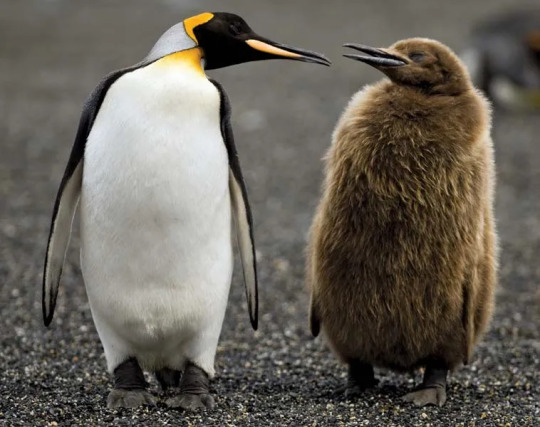
These two penguins both won against crested penguins. Little Blue won against the Erect-Crested, with the biggest gap of the round, while King won against the Fiordland.
A couple facts to take with us into round 2: Little Blue penguins are also called Little penguins, Blue penguins, or Fairy penguins. They are the smallest penguin species. King penguins are similar to Emperor penguins. This King penguin is pictured with a King penguin chick.
#polls#penguins#penguin competition#penguin tournament#round 2#tumblr poll#bracket#penguin#tournament#little blue penguin#fairy penguin#king penguin
34 notes
·
View notes
Text
A South Pacific Penguin Dumps One of Its Potential Chicks
https://sciencespies.com/news/a-south-pacific-penguin-dumps-one-of-its-potential-chicks/
A South Pacific Penguin Dumps One of Its Potential Chicks
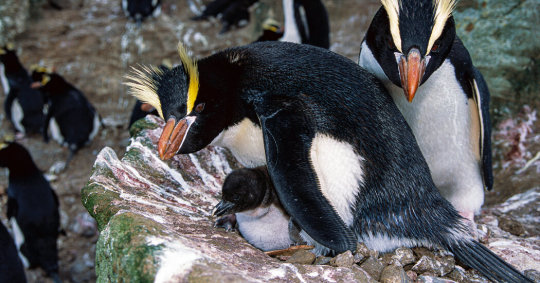
On the Antipodes Islands in the South Pacific, researchers observed a strange parenting move in erect-crested penguins — laying an egg that’s doomed to die.
In 1998, a team of researchers made the three-and-a-half day trek to the isolated Antipodes Islands in the South Pacific to study one of its few residents: the enigmatic and endangered erect-crested penguin.
“These are really the forgotten penguins,” said Lloyd Davis, a biologist and science communicator at the University of Otago in New Zealand, who led the team almost 25 years ago. “No one knows virtually anything about them.”
The modern plight of these birds inspired Dr. Davis, after decades of working in science communication, to revisit the data he and colleagues gathered in 1998. The results of their research were published on Wednesday in the journal PLOS ONE, chronicling the birds’ demographics and unique parenting style — including neglecting, and in some cases killing, potential chicks.
To describe the penguins’ native Antipodes Islands and nearby Bounty Islands as harsh would be an understatement almost as severe as the landscape itself. Known in the Māori language as Moutere Mahue (Abandoned Island) and Moutere Hauriri (Island of Angry Wind), they are technically part of New Zealand, though they sit hundreds of miles off its southern coast.
The islands have “a sort of bleak beauty,” said Dr. Davis. Aside from steep cliffs and severe winds, the only inhabitants of the islands are the penguins and other seabirds.
The research team arrived at the Antipodes Islands in September 1998 and stayed through the breeding season until November. They marked 270 penguins’ backs with yellow paint so the birds could be reliably tracked. The researchers counted the birds, observed their courtship, egg-laying and incubation behaviors, and gathered data on one of the most baffling features of crested penguin biology: they lay an egg that never hatches.
An erect-crested penguin colony on Antipodes Island, which has been observed by the research team since 1998.Tui De Roy/NPL/Minden Pictures
All species of crested penguin lay two eggs in a breeding season, a smaller first egg and a larger second egg, though this size difference is most extreme in erect-crested penguins. In other birds it’s usually the last egg that is smaller, only meant to be hatched and raised if the first eggs die — a sort of insurance policy. However, erect-crested penguins throw out their would-be insurance immediately, like a first attempt at a pancake not meant to be eaten. All of the smaller eggs that the team observed in 1998 died, mostly the day before or the day the larger egg was laid, suggesting the smaller egg did not evolve to be a backup plan.
That the first egg is smaller than the second egg has made crested penguins an enigma “for the last hundred years,” Dr. Davis said. “No one has come up with a good explanation for why this is.”
The smaller eggs often were not incubated by their parents, and most ended up rolling out of the nest or accidentally getting smashed. Occasionally, the penguins seemed to deliberately shove the tiny eggs out of their bare, rocky nests to their doom. The team in 1998 conducted an experiment: They built protective rock rings around some nests and compared the fates of those smaller eggs to those in unprotected nests. Even though the barrier saved some of them from rolling away, all were still neglected and died.
“You can see that from the penguin’s viewpoint, they want the bigger egg, and so they’re favoring the bigger egg,” said Dee Boersma, a conservation biologist at the University of Washington who was not involved with the study. While the ancestor to modern crested penguins raised two chicks, Dr. Davis suspected that food scarcity drove natural selection in today’s species to reduce their brood size to one.
This speculation will likely continue, as it is only getting harder to study erect-crested penguins. Dr. Davis says it is difficult to obtain permits to travel to these isolated islands. And while erect-crested penguin populations are at risk, they’re hardly alone. The related rockhopper penguin has seen a dramatic population crash, and globally, “penguins are in trouble,” says Dr. Boersma.
With the world warming at an alarming rate and continued exploitation of the oceans by humans, penguins face numerous threats. Dr. Davis said he hoped his paper would reintroduce the forgotten erect-crested penguin to the world and spark further research. “If you don’t know about them, you can’t care about them,” he said.
Until more research can be done, the reason crested penguins favor their second eggs remains a mystery. “So much is speculative because we just don’t know much about these birds,” Dr. Davis said.
#News
#10-2022 Science News#2022 Science News#acts of science#Earth Environment#earth science#Environment and Nature#everyday items#Nature Science#New#News Science Spies#October 2022 Science News#Our Nature#planetary science#production line#sci_evergreen1#Science#Science Channel#science documentary#Science News#Science Spies#Science Spies News#Space Physics & Nature#Space Science#News
2 notes
·
View notes
Text
0 notes